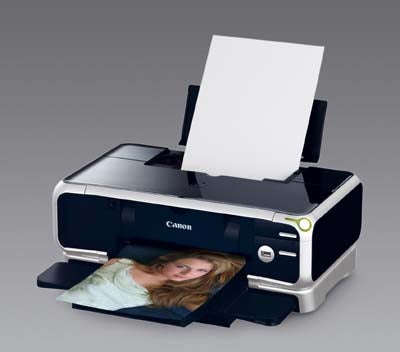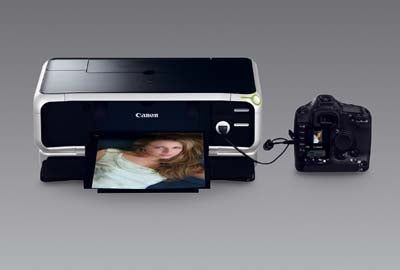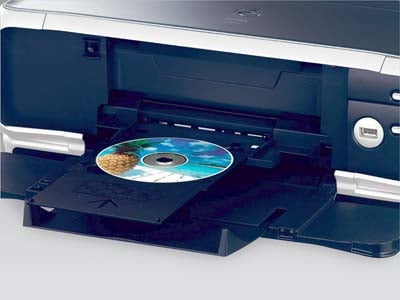Canon Pixma iP 8500 – Photo Printer Review
Canon Pixma iP 8500 – Photo Printer
The Pixma iP 8500 is a stunning photo printer, but as always, you get what you pay for.

Verdict
Key Specifications
- Review Price: £257.00
At first glance Canon’s Pixma iP 8500 looks suspiciously like the iP 5000, which we reviewed back in December 2004. So what extras does the Pixma iP 8500 have over its stable mate, which justify the extra £100? There’s just one; a unique eight-colour print system.
This involves a wide, lifetime print head and eight ink tanks, adding photo magenta, photo cyan, red and green to the standard cyan, magenta, yellow and black (CMYK). The print heads use Canon’s Full-photolithographic Inkjet Nozzle Engineering (FINE) technology and deliver two picolitre drops at a very fine resolution of 2,400 by 4,800dpi. This is ideal for photographic reproduction, but could slow day-to-day plain paper prints.

Looking like some oriental lacquer-work writing chest, the Pixma iP 8500 can be used self-contained, by filling the 150 sheet paper cassette sitting under the printer, or by lifting a flap on its top surface you can feed a further 150 sheets from a conventional, near-vertical tray at the rear. This combination is ideal if you want to load both A4 and, say 10cm by 15cm print paper at the same time.
All paper feeds out to a telescopic tray which unfolds from the front. When open you can also pull down an internal flap which provides a third feed option, for printing directly to CD or DVD blanks. To the right of the output tray is a USB socket for PictBridge-enabled cameras, though there’s no support for camera memory cards, which is a pity.
There are two PC connections to the printer, one USB and the other a fast USB 2.0. The only controls are for sheet feed and to select the paper source.

Printer drivers and two Canon utilities are easily installed from the supplied CD. The driver is well designed, with a useful Print Advisor which automatically sets up the machine for typical printing tasks. Easy Photo-Print and Easy-Toolbox combine to handle quick prints for a variety of paper sizes, a photo album and onto CD.
We noted the same problem with this printer as with the Pixma iP 5000, in that the status monitor refused to show ink usage correctly, even when we replaced empty cartridges with full ones. We used a high spec, USB 2.0 cable to connect the printer and can’t see why these levels aren’t correctly updated.
The Pixma iP 8500 prints colour photos quickly. A 5 x 3-inch photo took just 23 seconds, and mixed business graphics with text was also quick – our single A4 page completed in 24 seconds.
However, since the printer has an internal duplexer, we ran our 20 page, duplex text print and were surprised when the iP 8500 took nearly 13.5 minutes to complete the job. It appeared to stop after virtually every side to prime its black ink cartridge, even though the cartridge was newly installed and we’d set the driver to use only black ink.
So the print speed is variable, but what you really want to know about is the print quality, and it has to be said it’s pretty amazing. Canon claims to have added the red and green inks to enliven a range of colours and photo magenta and photo cyan give more accurate reproduction of light shades. Across a whole range of different photo types, the Pixma iP8500 excels at producing prints that are very close to photographic quality in tone and clarity.

Even though the printer has a permanent head, which shouldn’t need to be replaced during the life of the printer, and the individual ink cartridges should result in lower running costs, the Canon machine still isn’t cheap to run. The cheapest price we could find for an ink cartridge was £7.61 and genuine Canon Photo Paper Pro came out at just over 60p per A4 sheet.
Very unusually, Canon’s quoted page count for each cartridge, 210 pages at five per cent cover, was greatly exceeded in our tests. We had our first ink-out warning at 388 pages and only saw a drop in print quality after 467 pages, well over double Canon’s modest claim.
Using this print figure gives a cost per 20 per cent cover, full-colour page (slightly smaller than a 10cm x 15cm print) of 60.7p. In calculating a 20 per cent costing, we’ve assumed that using photo or red and green inks means correspondingly less CMYK inks, and since they’re all the same price, it won’t matter what the mix is. Canon could dramatically reduce the overall print cost if it made its photo paper available at prices similar to HP or Epson. Epson’s can be had for around 40p per A4 sheet and we can buy HP glossy photo paper for under 20p.
”’Verdict”’
The Pixma iP 8500 is intended for printing digital photographs and at this it is supremely good. Whether printing on A4, 10 x 15 or on CDs, photos come out superbly natural and detailed. It’s also quick when printing photos, but don’t duplex plain pages if you’re in a rush. Running costs are relatively high, so you need to balance that against the output quality.
(table:features)
(table:speed)
Trusted Score
Score in detail
-
Print Speed 8
-
Features 8
-
Value 8
-
Print Quality 10

